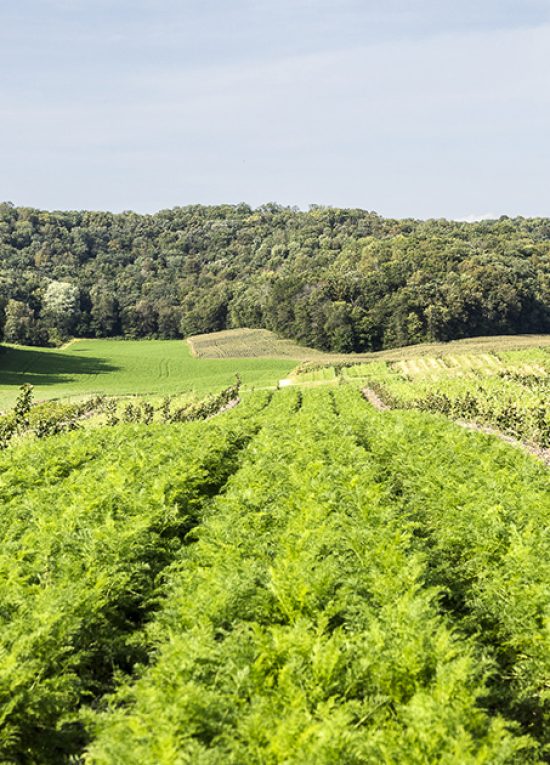4-H Memorial Camp
Monticello, IL
Savanna Institute Demonstration Farm
Farm Information
The 4-H Memorial Camp Demonstration Farm is located at Allerton Park, a 1,500-acre park in Monticello, IL, owned by the University of Illinois. Here, the Savanna Institute manages a 35-acre alley cropping demonstration farm that features rows of hardwood timber with alleys of annual row crop rotation.
Alley cropping is an in-field agroforestry practice where rows of trees are planted into productive agricultural systems. While alley cropping can be done with any crops at any scale, on the 35 acres at 4-H Memorial Camp, we planted six blocks of native timber trees into conventional corn and soybean grain production. This demonstration is designed to match our farmer partner’s equipment, planting, spraying, and harvest schedule, as well as their production goals. The alleys of row crops are 200 feet wide to accommodate two different sizes of machinery with 90-foot headlands for turning at the ends of rows. The trees are planted in rows that run west to east. This orientation was intentional, as it matched the cropping pattern of our farmer partner and helps stop and slow water from rainfall events that runs from the northeast to the southwest part of the field.
The tree blocks are 30 feet wide and vary from 1,300 to 650 feet long, with each accommodating three rows of trees. The first row of trees in each block is planted 5 feet from the alley; the second row is 10 feet from the first, and the third row is 10 feet from the second row and 5 feet from the adjacent alley. In all three rows, the trees are planted 10 feet apart. This will not be the final spacing, but dense planting establishment helps ensure quality timber production, tree survival, and habitat. The timber species, swamp white oak, black walnut, and shagbark hickory, are planted in the middle row. The two outer rows are smaller statured native trees and shrubs that will act as nurse plants and vital habitat for wildlife. Three blocks also feature a black locust for timber experiment where Savanna Institute is tracking tree growth rates and habits including thorn, pod, and sucker production. This tree, native to Illinois, has the potential to be a fast-growing, sustainable timber option for agroforestry systems and is also one of the few woody species that fixes nitrogen in soil.
On all three blocks, we’re also conducting a groundcover experiment where we’re looking at three different maintenance options on two different groundcovers. The tree maintenance options are: use of 3-foot herbicide bands, which keep soil bare with no vegetation; 3-foot plastic weed mats, which prevent weeds and keep moisture in soil; and mowing and weed wacking, which keeps vegetation low but in place. The two groundcovers are a low mow mix, composed of Dutch white clover, perennial ryegrass, and turf-type fescue, and a short-grass prairie mix, with native grasses and forbes. We’re currently tracking labor hours, cost, and tree growth but plan to include biodiversity and pollinator counts as well. This multiyear work with multiple partners is made possible through long-term relationship-building, kind and consistent communication, and a strong lease which clearly outlines the roles and responsibilities of each party. The 4-H Memorial Camp Demonstration Farm is an abundant, increasingly diverse farm that is growing toward a future that showcases the power of both/and. Both perennial production and annual cropping. Both established farmers and newer farmers. Both woody and herbaceous. Both long term and short term. Both highly productive and healthy. Both beautiful and hopeful.
4-H Memorial Camp is part of a network of demonstration farms operated by the Savanna Institute in Illinois and around the Midwest. Demonstration farms serve as learning hubs for farmers and landowners who want to add agroforestry to their sustainable farming practices.
Farm Information
Acres: 35
Acres: 35
Established: 2020
Located: Monticello, IL
Farmland Owner: University of Illinois, Urbana-Champaign
Partners: USDA, NCR SARE, 4-H Memorial Camp, Lourash Farms, Lumpkin Family Foundation
Research in Progress
- 6 tree blocks (30 feet x 1,650-650 feet) with 200-foot row-crop alleys
- 3 rows in each tree block
- 10-foot spacing between trees and rows
- 5-foot buffer between rows 1 and 3 and row crops
- Rows 1 & 3: Native nurse trees: eastern redbud, smooth alder, river birch, winterberry, chokecherry, and shadblow serviceberry
- Row 2: Native hardwood timber: black walnut, shagbark hickory, swamp white oak, and black locust timber experiment








